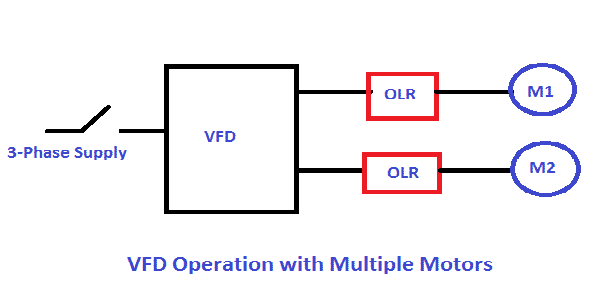Advantages of using one VFD to control multiple motors
- Saves money – because the cost of one bigger size VFD is less than the many smaller VFDs.
- Cut Cabinet size
- One large drive will have a smaller footprint than multiple smaller VFDs
- Reduce control & Power circuit complexity
- Cut design cost
- Reduce inventory stocking requirement
- Simple Parameter adjustment
VFD Sizing for Multiple motor operation with one VFD
The selection of the VFD is very important when we drive more numbers motors through VFD. VFD capacity is of paramount importance while selection.
The VFD KW rating must be 110 % of the driven load. If the driven equipment power is 100 KW, the VFD must be 110 KW and above. We connect two motors or more motors to the VFD inverter to run the motors in the same direction.
Controlling Multiple Motors with one VFD
The total load of all the motors must be somewhat less than the VFD KW rating. If two 30 KW motors connected to the VFD, then the drive rating should be =1.1(30+30)=66 KW. Thus 70 KW VFD is suitable for the application.
The motors connected to the output of the VFD must have the same rating and the same synchronous speed. If both the motors run in the same direction, then the motors accelerate with the same speed producing the additive torque for the driven load.
We can connect multiple motors to one VFD, till the capacity of motors does not exceed the capacity of the inverter. However, all the motors must start simultaneously in order to have a smaller size of the VFD. If the motors did not run simultaneously, then the size of the VFD will be bigger.
Where the single VFD for multiple motors are used?
We use multiple motors to drive the common load at the same speed. Examples of twin drives are vibrometers, bucket elevators, and Roller press. In this case, both the motors share the load at the same speed.
The key factors for controlling multiple motors with one VFD?
When the motors run with common VFD, the following parameterization must be done in VFD.
- The VFD drive must run on volt/Hz ( V/f ) mode. No vector control is possible in this case. Each motor will run at the same speed making this setup ideal for pump and fan applications.
- The current rating of the VFD must be equal to the sum of all motor’s current rating.
- In the case of driving multiple motors with a single VFD, auto-tuning is not possible. Therefore, do not perform auto-tuning.
- The individual motor should have separate overload and short circuit protection to protect the motor and drive. In case of tripping of the motor on account of overloads, the overload relay will trip the VFD.
Overload Protection in Multi-motor Applications with VFD
In this type of operation, individual motor overload protection on the load side is required. The VFD can sense the total current, but it can not sense the individual motor current. Thus, the VFD can not provide overload protection. To provide overload protection to motors, we can provide the followings;
- Electronic Overload Relay: The electronic relay is most accurate as far as current is sinusoidal. However, the VFD output voltage is not perfect sinusoidal and it is somewhat distorted. Thus the harmonics are present at the load side of the VFD. The current sensor of the electronic relay may not read the current accurately and may cause nuisance tripping. Therefore electronic relay is not used for individual motor protection.
- Motor Protection Circuit Breaker: The high voltage up to 3 to 4 times induced due to the standing wave reflection phenomenon of the VFD. Therefore, standard motor circuit protection breakers (MPCBs) are also not suitable for this application because the high voltage may damage the MPCB magnetic trip coil. Therefore, MPCB is not used for individual motor protection.
- Thermal overload relay: The thermal overload relay is most suitable for this application because the relay does not get affected by harmonics current or by induced high voltage. The thermal load relay functions on the principle of I2 R heating effect. Therefore, the thermal overload relay is most suited for this application.
Therefore, the individual motor must have its own thermal overload protection. The thermal overload relay is installed at the load side of the VFD for the individual motor. The contact of the thermal overload relays are paralleled to give trip contact to VF drive. Thus, the VFD will trip in case of overload tripping of the motor.
Control Scheme of Motors
